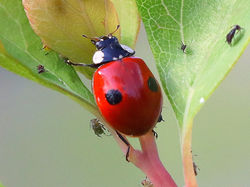top of page
Images courtesy of John Lindley
 16-spot LadybirdA tiny ladybird, common in the village but hard to spot because it spends most of its time buried deep in vegetation. It doesn't eat aphids - instead it feeds on pollen, plant fungi and occasionally nectar. |  24-spot LadybirdA tiny ladybird about 3mm long - the name is misleading because the number of spots is very variable. It's a grassland species and the best places to look for it in the village are along the roadside verges. There was a major local increase in numbers in 2023 compared to previous years |  Bryony LadybirdA large orange ladybird that was first recorded in the UK in 1997. Unusually for a ladybird, it doesn't eat aphids - indeed its diet is restricted to the leaves of White Bryony. First seen in the village in 2022, then more commonly in 2023. |
|---|---|---|
 Harlequin LadybirdFirst recorded in the UK in 2004, and now extremely common everywhere. It's an active predator on many insects, including other ladybird species. The markings are extremely variable, but it can normally be identified by the "batman" marking just behind the head. |  Cream-streaked LadybirdFirst seen in the UK in 1939, and still uncommon and localised. In the village, the best chance of seeing it is on low vegetation under Pine or Larch trees. |  Harlequin Ladybird |
 Harlequin Ladybird |  2-spot LadybirdOnce the most common species locally, it is now rare, due to the depradations of the invasive Harlequin Ladybird and climate change (it remains common in Northern England and Scotland). Like most ladybirds, it feeds on Aphids. |  10-spot LadybirdAnother species that has become much less common as a result of competition with the Harlequin Ladybird. It can be seen in the spring on low vegetation under a variety of tree species, but later on in the year it's harder to find, as the adults move up into the trees. |
 7-spot LadybirdThe most common and easily recognised of the UK ladybirds - it can be found in gardens and a wide range of other habitats. In some years, like September 2023, it can have population explosions, with hundreds being seen at any one time. |  Water LadybirdThis species is restricted to wetland habitat and can be found in the village near the river, where it lives on reeds and rushes. It's quite common where it does occur, but its small size and secretive behaviour makes it hard to find. |  14-spot LadybirdOne of the commonest species locally, it can be seen on low vegetation throughout the warmer months. The basic colour is very variable, ranging from whitish-grey to bright yellow, and the size of the black markings are also very variable. |
 Pine LadybirdA small, mostly black ladybird, and one of the first to become active in spring, when you are most likely to see it. Despite its name, it can be found on a variety of trees and shrubs if Pine is not present. |  Orange LadybirdPhoto taken in Goring. A medium sized ladybird that can be found in gardens on shrubs and in wooded areas. Once considered a rarity, its numbers have increased over the last 20 years, probably as a result of climate change. |
Click here to return to the main Gallery page
bottom of page
